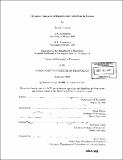Dynamic analysis of equilibrium selection in games
Author(s)
Amaya, Kenichi, 1973-
DownloadFull printable version (2.782Mb)
Other Contributors
Massachusetts Institute of Technology. Dept. of Economics.
Advisor
Glenn Ellison and Muhamet Yildiz
Terms of use
Metadata
Show full item recordAbstract
Chapter 1 analyzes how pre-play communication and evolution together do or do not lead to socially efficient equilibria in 2 x 2 symmetric coordination games. In our evolutionary dynamics, there are committed players who can choose only one particular action of the base game, as well as those players who can choose message contingent actions, and the evolution in the choice of message is faster than the evolution in actions. We show the Pareto efficient equilibria are selected if and only if the base game satisfies the self-signalling condition, which means that a player has an incentive to convince the opponent that he is going to play the Pareto efficient equilibrium strategy if and only if he is actually planning to play that strategy. Chapter 2 analyzes a stochastic evolutionary dynamics of Kandori-Mailath-Rob (1993) in Spence's job-market signaling model. In contrast to Nldeke and Samuelson's (1997) analysis which showed the Riley equilibrium is selected only if it is undefeated, we show that the Riley equilibrium is always selected. The key which makes this difference is how mutations affect players' behavior. While Noldeke and Samuelson allow a single mutation to change players' actions drastically, we consider a model where players change behavior only slightly if the number of mutations is small. Chapter 3 analyzes pure strategy Markov perfect equilibria in two player asynchronous choice repeated games where the stage game is a 2 x 2 game. We show that Markov perfect equilibrium leads players to behave differently from the static Nash equilibrium in some environments, while in other environment it gives equilibrium selection results.
Description
Thesis (Ph. D.)--Massachusetts Institute of Technology, Dept. of Economics, 2003. Includes bibliographical references.
Date issued
2003Department
Massachusetts Institute of Technology. Department of EconomicsPublisher
Massachusetts Institute of Technology
Keywords
Economics.